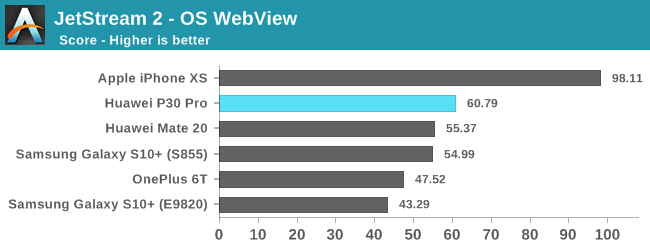The Huawei P30 & P30 Pro Reviews: Photography Enhanced
by Andrei Frumusanu on April 18, 2019 9:00 AM EST- Posted in
- Mobile
- Smartphones
- Huawei
- P30
- P30 Pro
System Performance
System performance of the new P30s is expected to be excellent. In essence, there shouldn’t be any large difference to the Mate 20’s and the recent Honor View20. All of the aforementioned devices sport the same Kirin 980 chipset as the P30s, and there shouldn’t be any major software differences in the new flagship phones.






Indeed, in PCMark, the P30 and P30 Pro tie in with the recent Huawei flagships, showcasing only minor deviations in the scores.



Interestingly, we see a slightly larger uplift in the web benchmarks, however I found this not to be caused by an increase in performance of the devices themselves but rather seemingly an update in the OS WebView of Android, as re-testing the Mate 20 again showcases the same increased performance figures.
Overall, the P30 and P30 Pro perform identically to the Mate 20 and Mate 20 Pro – excellently. There’s still instances where Qualcomm (& new Exynos S10) devices perform notably better, such as app opening or activity switching. I think this is due to Huawei’s possible lack of framework boosters.










85 Comments
View All Comments
SwordOS - Thursday, April 18, 2019 - link
@Andrei, you're saying the galaxy s10+ battery life is better than the p30 pro's one, but reviewers everywhere are still saying that the battery life on the p30pro is phenomenal and you can hit 2 days of usage, while with the s10+ (and s10) you can barely hit one day of usage. Also, the difference in battery life between wifi and 4g with the galaxy s10+ (at least for the exynos variant) seems to be way more noticeable than on the p30pro. Did you also try these phones in a real day of usage? Maybe benchmarks cannot be translated to real life usage..Andrei Frumusanu - Thursday, April 18, 2019 - link
> and you can hit 2 days of usage, while with the s10+ (and s10) you can barely hit one day of usageSuch claims are just bollocks. I have the S10+ Exynos as a daily and I'm sitting at 47% at 2 days with 5h screentime. Similarly the P30 Pro isn't bad but it just doesn't last as long due to the base power simply being 120mW less efficient.
SwordOS - Thursday, April 18, 2019 - link
so are all european reviewers lying except you? I trust you, but this is strangeAndrei Frumusanu - Thursday, April 18, 2019 - link
Yes, most European reviewers have their data wrong. It's because they didn't identify some firmware issues and got the articles out as soon as possible. I identified the issues and avoided it for the review; meanwhile Samsung has issued firmware updates at the end of March which fixed the drain issues. Of course those reviews weren't updated.SwordOS - Thursday, April 18, 2019 - link
Did drain issues occurred only after making a voip call or even for other reasons?RMerlin - Thursday, April 18, 2019 - link
"Huawei still uses Broadcom BCM4359 WiFi combo chips" AFAIK, they use a HiSilicon Hi1103.Andrei Frumusanu - Thursday, April 18, 2019 - link
Went and checked again, you're right. I was tricked by the phone still coming with the BCM4359 firmware.s.yu - Thursday, April 18, 2019 - link
Now why do they have Broadcom firmware if they use their own modem?N Zaljov - Friday, April 19, 2019 - link
Probably BSP leftovers. Some Hi3680-based boards still use a BCM4359, and since most of the devices will rely on the same BSP (with minor little additions like bindings for the various different batteries, displays etc. that Huawei uses), they most probably just kept the Broadcom stuff in there.nicolaim - Thursday, April 18, 2019 - link
749€ for a phone with no OIS, no waterproofing, and no wireless charging? No thanks.